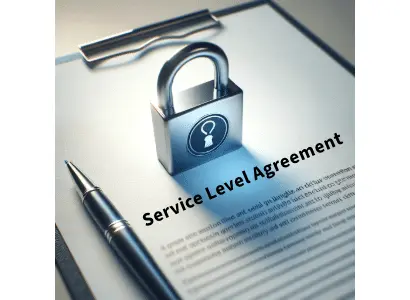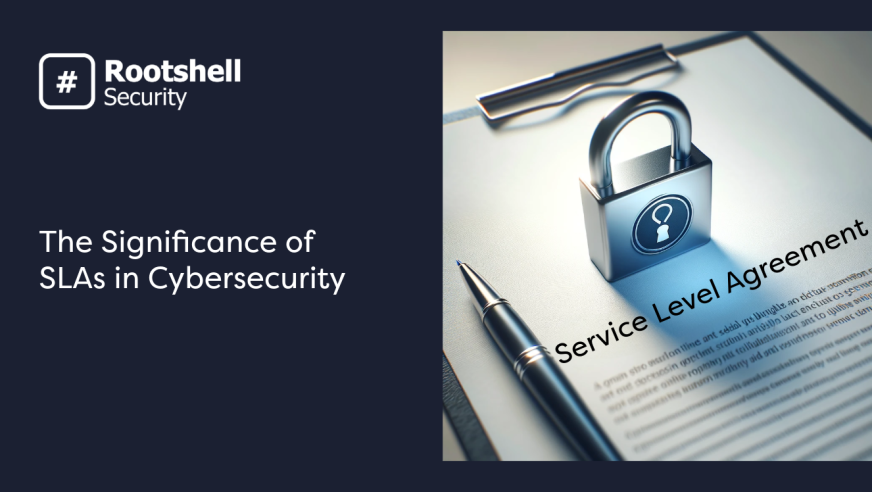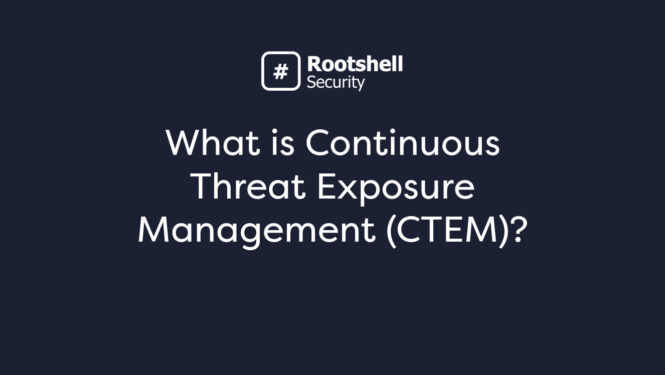As a business, you have always had to be vigilant about cyber threats. In the past, attacks were more indiscriminate, similar to casting a wide net. Today, however, threat actors employ AI to craft attacks that are far more personalized and targeted. To effectively counteract these sophisticated threats, you must establish an in-house information security team or engage with a managed security service provider (MSSP). Alongside these defenses, implementing ‘SLA cyber security‘ measures is invaluable, providing a structured approach to managing and mitigating these threats.

According to the National Crime Agency (NCA), ransomware attacks are likely to increase with advancements in AI technology. This means that your business faces a plethora of more complex threats.
Service Level Agreements play a key role in setting standards and expectations for security service levels. In this guide, we’ll explore how important SLAs are in establishing robust cybersecurity policies and regulating compliance with data confidentiality requirements, especially for handling sensitive government data. We’ll shine a light on their roles in establishing robust cybersecurity policies and regulating compliance.
What is a SLA in cyber security?
Before we delve into specifics, let’s understand what SLAs are in the cybersecurity context. The quick definition: Service level agreements (SLAs) are contractual provisions that detail the duties of service providers and establish precise expectations concerning cybersecurity, including vulnerability management and data confidentiality requirements.
Now, for the longer explanation.
A Service Level Agreement (SLA) in cybersecurity is a contract between a service provider, such as a Managed Security Service Provider (MSSP), and you, the client. It details the duties of service providers and establishes precise expectations concerning cybersecurity, including vulnerability management and data confidentiality requirements, enabling organizations to draft SLAs that specifically address these areas.
SLAs facilitate trust and dependability between the parties involved. They help establish a strong customer-service provider relationship, ensuring customer satisfaction while delineating responsibilities for all stakeholders, including those dealing with sensitive data required by government agencies.
Applying a Security Service Level Agreement
Within the cybersecurity context, SLAs are foundational for effective security management, setting specific expectations for response times, security measures, and compliance with regulatory standards, such as those outlined in NIST SP guidelines. They are particularly vital in environments that involve cloud services or the exchange of legal documents, where service credits may be leveraged for non-compliance.
Moreover, SLAs ensure adherence to regulations and standards, underscoring the importance of clear communication, formal agreements, and periodic reviews to maintain effectual cybersecurity management. This contractual framework not only delineates the level of service and service availability but also establishes a clear contract between the service provider and the client, facilitating a systematic approach to managing information security and data management within the dynamic landscape of cybersecurity.
Why are SLAs Used in Cyber Security?
SLAs are more than just mere contractual formalities. Their strategic value extends far beyond setting expectations for service delivery, profoundly impacting business operations and the overarching security posture.
Here’s why they are important.
Strategic Risk Management
Service Level Agreements (SLAs) play a vital role in managing cybersecurity risks by clearly defining the roles, responsibilities, measurements, and customer expectations of both service providers and clients. This clarity is instrumental in identifying potential vulnerabilities and threats, enabling organizations to implement effective preemptive measures and response strategies.
They set standards for security performance, including minimum service levels and response times to incidents, ensuring that risks are systematically managed and mitigated. This aspect is especially critical for business entities reliant on cybersecurity and internet service providers for their operations.
Cost Efficiency
In cybersecurity, resources are often limited, so SLAs play a crucial role in ensuring cost efficiency. By specifying service scopes and expectations, organizations can align their cybersecurity investments with their most critical needs and risk profiles.
This targeted allocation aids in avoiding overinvestment in non-essential areas and underinvestment in critical ones, effectively managing procurement and data management processes.
Fostering a Proactive Security Culture
The Role of SLAs in Cybersecurity Awareness
SLAs are instrumental in fostering a proactive security culture within organizations by setting clear standards to prevent poor performance. These agreements formalize the importance of cybersecurity measures and establish clear guidelines for their implementation and monitoring. They contribute to a heightened awareness and understanding of information security issues among all stakeholders. This proactive approach encourages continuous improvement, learning, and adaptation—traits crucial in the face of evolving cyber threats.
Enhancing Communication and Collaboration
Moreover, SLAs facilitate transparent communication between service providers and clients, fostering a collaborative approach to cybersecurity. This collaboration is essential for addressing complex security challenges and adapting to the dynamic nature of cyber threats, ensuring that both parties work towards common goals while sharing knowledge, insights, and best practices.
SLAs as Strategic Enablers
In essence, SLAs act as strategic enablers, driving better security practices, enhancing operational efficiencies, and fostering a resilient and responsive security culture. They are vital for ensuring that cybersecurity measures are aligned with business objectives and meet internal SLA standards, thereby fulfilling the type of service expected by clients and dictated by regulatory bodies such as the CSRC.
Establishing a Common Framework for Cybersecurity
By establishing a common glossary of terms and expectations, SLAs help organizations navigate the complex cybersecurity landscape, preparing them to manage and mitigate risks effectively. This common framework is key to the strategic management of cybersecurity efforts and ensures that all organizational members are on the same page regarding security priorities and protocols.
Who Needs a Service Level Agreement?
SLAs are not exclusive to any specific sector or size of organization. Their adaptability and essential role in clarifying service expectations make them indispensable across the spectrum, including for individual contractors who might deal with free word or rental agreement templates as part of their document template collection for various service levels.
Small to Large Enterprises
Businesses of all sizes use these service-level agreements to make sure that cybersecurity measures are in place and are being monitored and improved over time.
These agreements help small businesses understand and manage their risks with limited resources. At the same time, large enterprises benefit from the scalability and customization these agreements offer, which allows them to negotiate terms that address specific performance issues.
SLAs help manage complex security needs across diverse departments and operations.
Government Entities
The protection of sensitive information is crucial in government departments. SLAs serve as a vital tool in establishing and maintaining high standards of cybersecurity. They ensure that third-party services meet strict compliance and security standards, which are crucial for maintaining public trust and safeguarding national security.
Individual Contractors
For individual contractors offering cybersecurity services, these contracts articulate the scope of their responsibilities and the standards they must meet. They provide a clear basis for their engagements with clients.
This helps manage client expectations and also establishes the contractor’s credibility and trust in cybersecurity.
In essence, SLAs in cybersecurity are a universal need, transcending the boundaries of organization size, sector, or between two parties. They are fundamental in establishing a common understanding and approach to managing cybersecurity risks. They guarantee that all parties involved have a clear roadmap for protecting digital assets against cyber threats, thereby deploying use SLAs as a strategy.

Key Elements of a Service-Level Agreement
An effective service-level agreement should clearly define security-related SLAs, including agreement templates that specify service levels, security requirements, and assure compliance.
Here are some of the components that make an effective SLA.
Agreement Overview
This section provides a high-level summary of the agreement, including its purpose, scope, and the parties involved. It sets the stage for the detailed terms that follow, offering context and framing the intent behind the agreement.
The overview should articulate the main objectives of the cybersecurity services being provided.
Description of Services Included
The document should provide a detailed enumeration of the cybersecurity services covered, such as continuous monitoring, threat analysis, incident response, and security updates.
This section should clearly articulate what services the client can expect, including any data confidentiality requirements and methods to protect sensitive data, crucial for government agencies or businesses processing sensitive government data.
Description of Services Not Included
Equally important is outlining what services are not covered under the service agreement. This clarity helps manage client expectations and delineates the boundaries of the service provider’s responsibilities.
It may also guide clients towards additional services they might need to secure separately.
Redressing
This part explains how to address and resolve issues or disputes related to the service agreement execution or interpretation. It includes the steps a client can take if they feel the service levels agreed upon are not being met.
Stakeholders and Their Responsibilities
You can ensure accountability by identifying all parties involved in the SLA and defining their roles and responsibilities. This includes the service provider and the client. It may also include any third parties or subcontractors who play a role in delivering cybersecurity services.
All Security Measures
Any service provider would have to ensure that your business data is not compromised in the process. That’s why the agreement should include a comprehensive list of all security measures and controls that will be implemented as part of the service delivery.
This should cover both technical measures, such as encryption and firewall deployment, and procedural measures, like security audits and employee training programs.
Risk Management and Disaster Recovery
A comprehensive SLA would detail the strategies for identifying, assessing, and mitigating cybersecurity risks. It should also list plans for disaster recovery and business continuity in the event of a security breach or other disruptions.
This section underscores the proactive and reactive measures in place to protect the client’s assets.
Tracking and Reporting of Service
When you employ a service, you need a measure of how successful it proves to be to determine your returns on investment. The tracking and reporting define how the service provider will track performance against the agreed-upon metrics and how and when they will report this performance to the client. This ensures transparency and enables the client to monitor the service levels being provided actively, essential for maintaining data confidentiality and meeting security requirements.
A Timetable for Reviews and Process Changes
To keep up with evolving threats, you need to rethink your strategy periodically. That’s why you need a schedule for regularly reviewing the service agreement and making necessary adjustments to reflect changes in technology, threats, business operations, or regulatory requirements. This ensures that the SLA remains relevant and effective over time, especially in addressing poor performance.
The Process for Termination of Services
If either you or the service provider are not happy with your arrangement, you need a way to opt out of the service. To cover the eventuality of non-compliance with security requirements, the contract should include the conditions under which either party can terminate the agreement, including notice periods, the process for winding down services, and the handling of any data or resources upon termination. This ensures a clear exit strategy is in place for both parties.
Signatures
The final section of the SLA, where all parties involved formally agree to the terms laid out in the document. This may include digital or physical signatures from authorized representatives of the service provider, the client, and any other stakeholders specified in the agreement.
Each of these components plays a vital role in creating an agreement that is not only comprehensive and detailed but also clear and actionable, laying a solid foundation for a successful and secure partnership.
Types of SLAs in Cybersecurity
In the IT Infrastructure Library (ITIL), SLAs can be of three types. These are customer, internal, and multi-level service-level agreements.
Customer-Based
Customer-based SLAs focus on the specific service promised to each customer. Since they are between the service provider and its external customers, they may also be called external service agreements.
Service-Based
Service-based contracts encompass an overall agreement for all customers using a particular service. These are also called internal SLAs, as they are generally for customers within the organization, department, or site.
MultiLevel
The multilevel SLAs simplify the arrangement by segregating it into different levels.
- Corporate-level – This focuses on matters from the top company level that apply to every customer across the organization.
- Customer-level – This level deals with the service issues particular to a group of customers using the specific service.
- Service Level – This level is specific to the individual service relating to how that service will be provided.
All these agreements aim to improve service and protect customers by ensuring measurable performance levels, commonly used regardless of their type or structure. This is particularly important in cyber security contexts where cloud services or sensitive data are involved.

Key Components of SLAs in Cybersecurity
Robust SLAs are deep-rooted in the ITIL approach to service management, including specifying security measures and outlining problem management and response times to meet security requirements effectively. They are characteristically extensive, encompassing a broad range of key components. These components empower organizations to aptly navigate the challenging cybersecurity landscapes. They help the service providers deliver reliable services, and efficiently manage any arising security incidents.
The key components include:
Defining Service Levels
Defining service requirements forms the fulcrum of any service agreement. It includes detailing service standards and performance levels while extensively articulating the expected service performance. A clear service type description should accompany the definition of the service levels.
Specifying Security Measures
Each SLA must define specific security standards applicable to the service provider. This includes data encryption practices, intrusion detection techniques, firewall usage, antivirus strategies, and other security measures.
Outlining Problem Management and Response Times
The agreement should specify the procedures and the response times in case of any security incidents. It should provide for primary problem-resolution procedures and include clauses for escalation and backup mechanisms.
Compliance with Industry Regulations and Standards
SLAs should align with the industry’s current regulations and standards to mitigate performance issues. As cybersecurity practices evolve, the services should be flexible enough to adapt to these changes and ensure continuous compliance.
Service Reporting and Review
Regular monitoring and reporting on the quality of the services being provided are necessary. The agreement should clarify the metrics used to measure service performance. It should also stipulate the frequency of performance reports and service reviews.
Penalty Clauses
The SLA should include clear-cut penalty clauses in case the service provider fails to meet expectations or comply with the defined service standards.
Enforcing SLAs and Ensuring Cybersecurity Compliance
In the world of cybersecurity, just penning a comprehensive SLA is not sufficient. Rigorous enforcement and continual compliance are also crucial. Every contract needs a clause to measure performance and impose penalties when agreed-upon service standards are not achieved.
To actualize these enforcement mechanisms, service agreements ought to have embedded tools to track service metrics. This can involve a blend of automated tracking systems, such as software that monitors response times, and manual tracking procedures like periodic review of service reports. It’s vital to regularly interpret and react to these metrics to drive service improvements and guarantee compliance with regulations.
Considerations for SLA metrics
Effective compliance depends on the transparency of these metrics and the clarity of the penalty clauses, including service credits for non-compliance, a crucial aspect of security-related SLAs. In scenarios where service standards are repeatedly sub-par, escalating penalties could kick in. Additionally, a termination clause outlining the conditions for termination of the agreement due to non-compliance might come into play.
Take Control of Your Cybersecurity With Rootshell
The world of cybersecurity is multifaceted, intricate, and constantly changing. In such a reality, SLAs act as the compass. They provide direction, set the pace, specify the course, and facilitate smooth navigation across the complex digital landscape.
Maintaining cybersecurity is not an end state but a continuous journey that calls for adaptability, cutting-edge knowledge, and diligent measures. A well-defined, comprehensive, and rigorously enforced SLA can make this journey easier.
At Rootshell, we understand the importance of these contracts. We have created customizable email content for our platform, specifically designed to meet your SLA requirements.
Would you like to learn more about our customizable SLA update?



